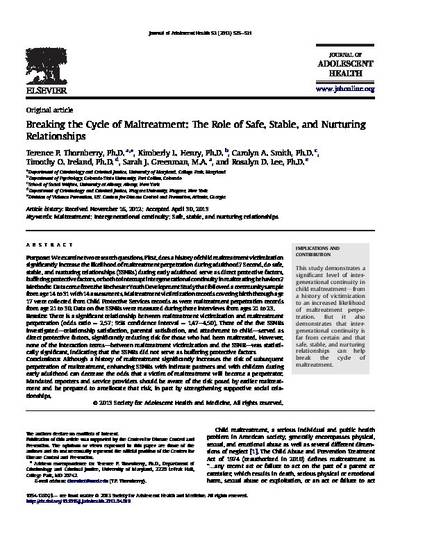
- Maltreatment,
- Intergenerational continuity,
- Safe stable and nurturing relationships
Purpose
We examine two research questions. First, does a history of child maltreatment victimization significantly increase the likelihood of maltreatment perpetration during adulthood? Second, do safe, stable, and nurturing relationships (SSNRs) during early adulthood serve as direct protective factors, buffering protective factors, or both to interrupt intergenerational continuity in maltreating behaviors?
Methods
Data come from the Rochester Youth Development Study that followed a community sample from age 14 to 31 with 14 assessments. Maltreatment victimization records covering birth through age 17 were collected from Child Protective Services records as were maltreatment perpetration records from age 21 to 30. Data on five SSNRs were measured during three interviews from ages 21 to 23.
Results
There is a significant relationship between maltreatment victimization and maltreatment perpetration (odds ratio = 2.57; 95% confidence interval = 1.47–4.50). Three of the five SSNRs investigated—relationship satisfaction, parental satisfaction, and attachment to child—served as direct protective factors, significantly reducing risk for those who had been maltreated. However, none of the interaction terms—between maltreatment victimization and the SSNR—was statistically significant, indicating that the SSNRs did not serve as buffering protective factors
Conclusions
Although a history of maltreatment significantly increases the risk of subsequent perpetration of maltreatment, enhancing SSNRs with intimate partners and with children during early adulthood can decrease the odds that a victim of maltreatment will become a perpetrator. Mandated reporters and service providers should be aware of the risk posed by earlier maltreatment and be prepared to ameliorate that risk, in part by strengthening supportive social relationships.
This article was published using the Elsevier Open Access model. All rights reserved. The Version of Record can be found at: http://www.sciencedirect.com/science/article/pii/S1054139X13002656
Available at: http://works.bepress.com/sarah-greenman/23/
